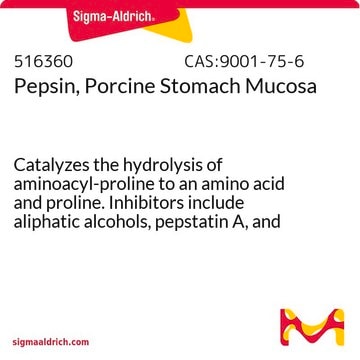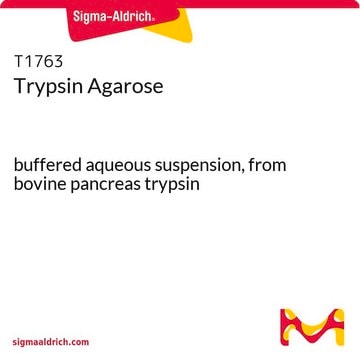P0609
Pepsin−Agarose from porcine gastric mucosa
lyophilized powder, ≥30 units/mg dry solid
Synonym(s):
Pepsin A
Sign Into View Organizational & Contract Pricing
All Photos(3)
About This Item
MDL number:
UNSPSC Code:
12352204
NACRES:
NA.54
Recommended Products
biological source
Porcine gastric mucosa
form
lyophilized powder
specific activity
≥30 units/mg dry solid
mol wt
35 kDa
matrix
4% cross-linked beaded agarose
UniProt accession no.
storage temp.
−20°C
Gene Information
pig ... LOC396892(396892)
General description
Pepsin is an enzyme found in gastric secretion.
Application
Pepsin immobilized onto agarose beads can be used to digest and then separate out the active peptides of the glycoprotein gliadin.
Pepsin-agarose has been used as an immobilization tool to investigate the refolding ability of the pepsin enzyme. It has also been used for the preparation of F(ab′)2 fragments from rabbit IgG.
Used to produce F(ab′)2 fragments of antibodies.1
Biochem/physiol Actions
Preferentially cleaves C-terminal to Phe, Leu and Glu. It does not cleave at Val, Ala or Gly. pH optimum 2-4. Active in 4 M urea and 3 M guanidine HCl. Stable at 60 °C. Pepsin is irreversibly inactivated at pH > 6.
Unit Definition
One unit will produce a ΔA280 of 0.001 per min at pH 2.0 at 37 °C, measured as TCA-soluble products using hemoglobin as substrate. (Final volume = 16 mL. Light path = 1 cm.)
Quantity
One gram solid swells to 5-10ml packed gel.
Physical form
Lyophilized powder stabilized with lactose
inhibitor
Product No.
Description
Pricing
Signal Word
Danger
Hazard Statements
Precautionary Statements
Hazard Classifications
Resp. Sens. 1
Storage Class Code
11 - Combustible Solids
WGK
WGK 3
Flash Point(F)
Not applicable
Flash Point(C)
Not applicable
Personal Protective Equipment
dust mask type N95 (US), Eyeshields, Gloves
Certificates of Analysis (COA)
Search for Certificates of Analysis (COA) by entering the products Lot/Batch Number. Lot and Batch Numbers can be found on a product’s label following the words ‘Lot’ or ‘Batch’.
Already Own This Product?
Find documentation for the products that you have recently purchased in the Document Library.
Customers Also Viewed
Ludmila Tucková et al.
Journal of leukocyte biology, 71(4), 625-631 (2002-04-03)
Celiac disease, induced by dietary gluten, is characterized by mucosal atrophy and local inflammation associated with cell infiltration and activation. Unlike other food proteins, gluten and its proteolytic fragments, besides inducing a specific immune response, were shown to activate components
M Feldman et al.
Gastroenterology, 110(4), 1043-1052 (1996-04-01)
Recent studies suggesting that gastric secretion does not decrease with aging included few elderly individuals and measured only acid secretion. The aims of this study were to measure gastric acid and pepsin output in 206 health Americans (age range, 18-98
Thomas A Kraus et al.
The Journal of clinical investigation, 115(8), 2234-2243 (2005-07-26)
To explore the requirement for M cells and the Peyer's patch (PP) in induction of oral tolerance and address the potential in vivo role of intestinal epithelial cells as nonprofessional APCs, we have attempted to induce tolerance in mice with
Widya A Wahab et al.
International journal of experimental pathology, 97(4), 303-309 (2016-09-24)
Coeliac disease (CD) is an inflammatory disorder of the small intestine. It includes aberrant adaptive immunity with presentation of CD toxic gluten peptides by HLA-DQ2 or DQ8 molecules to gluten-sensitive T cells. A ω-gliadin/C-hordein peptide (QPFPQPEQPFPW) and a rye-derived secalin
Katrine Lindholm Bøgh et al.
International archives of allergy and immunology, 161(1), 21-36 (2012-12-22)
It is generally believed that protein hydrolysis in the gastrointestinal tract decreases the allergenicity of food allergens. However, it remains unknown if specific properties of digestion products determine whether a sensitisation or tolerogenic immune response will develop. We sought to
Our team of scientists has experience in all areas of research including Life Science, Material Science, Chemical Synthesis, Chromatography, Analytical and many others.
Contact Technical Service









